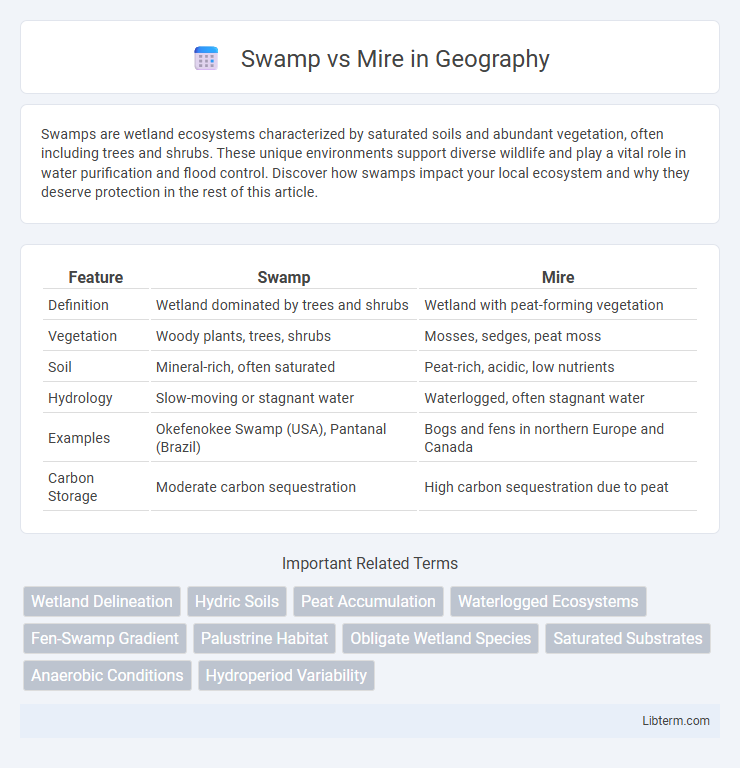Swamps are wetland ecosystems characterized by saturated soils and abundant vegetation, often including trees and shrubs. These unique environments support diverse wildlife and play a vital role in water purification and flood control. Discover how swamps impact your local ecosystem and why they deserve protection in the rest of this article.
Table of Comparison
| Feature | Swamp | Mire |
|---|---|---|
| Definition | Wetland dominated by trees and shrubs | Wetland with peat-forming vegetation |
| Vegetation | Woody plants, trees, shrubs | Mosses, sedges, peat moss |
| Soil | Mineral-rich, often saturated | Peat-rich, acidic, low nutrients |
| Hydrology | Slow-moving or stagnant water | Waterlogged, often stagnant water |
| Examples | Okefenokee Swamp (USA), Pantanal (Brazil) | Bogs and fens in northern Europe and Canada |
| Carbon Storage | Moderate carbon sequestration | High carbon sequestration due to peat |
Understanding Wetland Ecosystems
Swamps and mires are distinct types of wetlands, each playing a unique role in wetland ecosystems. Swamps are forested wetlands dominated by trees and often feature standing water, contributing to biodiversity by providing habitat for a variety of wildlife. Mires, characterized by peat accumulation and acidic, waterlogged conditions, are crucial carbon sinks that regulate water quality and support specialized plant species like sphagnum mosses.
Defining Swamp and Mire
A swamp is a type of wetland characterized by saturated soils and the presence of woody plants such as trees and shrubs, creating a forested ecosystem. A mire, on the other hand, is a wetland dominated by peat-forming vegetation, primarily mosses, which leads to the accumulation of organic matter and waterlogged conditions. Both swamps and mires play critical roles in carbon storage, water purification, and habitat provision but differ significantly in their vegetation structure and hydrology.
Key Environmental Differences
Swamps are wetlands dominated by woody vegetation like trees and shrubs, typically found in low-lying areas with slow-moving or stagnant water, supporting diverse aquatic life and rich biodiversity. Mires, including bogs and fens, are types of peat-accumulating wetlands characterized by acidic, waterlogged soils with low nutrient availability, favoring sphagnum mosses and specialized plant species. The key environmental difference lies in swamps' nutrient-rich, more oxygenated water supporting varied flora and fauna, whereas mires have nutrient-poor, highly acidic conditions that slow decomposition and promote peat formation.
Vegetation in Swamps vs. Mires
Swamps are wetlands dominated by woody vegetation such as trees and shrubs, providing a dense canopy that supports diverse wildlife habitats. Mires, including bogs and fens, are characterized by peat-accumulating vegetation like sphagnum mosses, sedges, and ericaceous shrubs, creating acidic or alkaline conditions depending on the mire type. The distinct vegetation in swamps and mires influences their hydrology, nutrient cycling, and ecological function within wetland ecosystems.
Wildlife Habitats and Biodiversity
Swamps, characterized by standing water and dense vegetation, provide critical habitats for amphibians, birds, and fish, supporting high biodiversity with species adapted to wet, oxygen-poor environments. Mires, including bogs and fens, feature waterlogged, acidic soils that foster specialized plant species like sphagnum moss and carnivorous plants, creating unique ecosystems for insects, birds, and rare mammals. Both wetlands contribute essential ecological functions but differ in hydrology and nutrient availability, influencing the diversity and types of wildlife they sustain.
Formation and Geological Processes
Swamps form in low-lying areas where stagnant water accumulates, promoting the growth of woody plants and trees through slow sediment deposition and organic matter buildup. Mires develop in wetter, peat-rich environments where incomplete decomposition of plant material creates thick, acidic peat layers, often in cooler climates with poor drainage. Geological processes such as sedimentation, hydrology, and peat accumulation distinctly influence the ecological characteristics and soil composition of swamps and mires.
Water Sources and Hydrology
Swamps are wetlands dominated by standing or slow-moving freshwater sourced from rivers, lakes, or groundwater, with hydrology characterized by periodic flooding and saturated soils supporting diverse flora. Mires consist primarily of peat-accumulating wetlands where water saturation comes from precipitation and limited drainage, resulting in acidic, nutrient-poor conditions and a stable water table. The hydrological differences influence ecosystem functions, with swamps hosting dynamic water flow patterns and mires maintaining consistent, waterlogged environments essential for peat formation.
Ecological Roles and Functions
Swamps and mires both serve critical ecological roles by providing unique habitats that support diverse plant and animal species, contributing to biodiversity preservation. Swamps, characterized by forested wetland conditions, play a significant role in water filtration, flood control, and carbon sequestration through dense tree roots and soil. Mires, including bogs and fens, function as natural carbon sinks by accumulating peat, thereby regulating greenhouse gases and maintaining hydrological balance in surrounding ecosystems.
Human Impact and Conservation
Swamps, characterized by woody vegetation, and mires, dominated by peat-forming mosses, both face significant human impacts such as drainage for agriculture and urban development, leading to habitat loss and reduced biodiversity. Conservation efforts prioritize restoring natural hydrology to maintain carbon storage capabilities and protect endemic species critical for ecosystem stability. Effective management incorporates wetland preservation policies, reforestation, and sustainable land-use planning to mitigate degradation and promote ecological resilience.
Swamp and Mire: Choosing the Right Term
Swamp refers to a wetland dominated by trees and shrubs with standing water, often rich in biodiversity and located in low-lying areas. Mire describes a type of peat-forming wetland characterized by waterlogged, acidic conditions and dense vegetation like mosses and sedges, typically accumulating organic matter. Choosing the right term depends on the wetland's vegetation type and hydrology, with swamp emphasizing woody plants and mire focusing on peat accumulation and acidic soils.
Swamp Infographic

 libterm.com
libterm.com